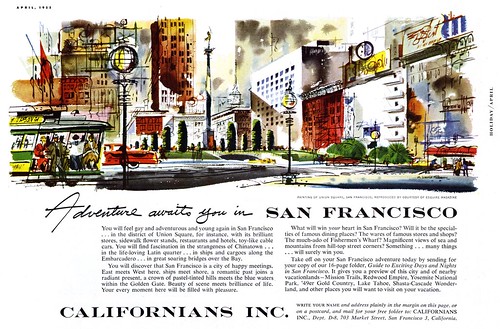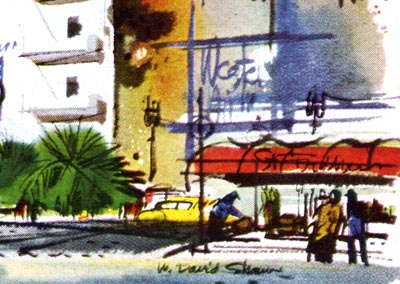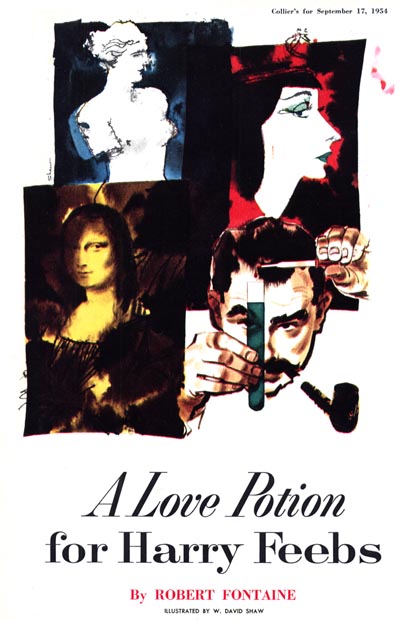
"It may be hard for you to understand how that childish delusion could affect my later attitude toward life but, seriously, it did; it gave me a confidence in myself which I know has been a big factor in whatever success I have attained."

"I have always believed in myself - and I think that is important for an artist, for every creative person."

Shaw continues, "Many artists make the mistake of trying to anticipate what the client might have in his mind or in trying to copy a style that is currently popular, rather than in asserting and promoting their own original ideas. When, five years ago, I first showed the kind of work I am now doing, it was not readily accepted. I had to be very persistent in it. Now I am kept busy supplying the demand for exactly the sort of thing I can do best and love best to do."

Above, what might have been an early indication that Shaw was on the right track, this piece was recognized by the Art Directors Club of New York for inclusion on nearly the last page of their 1948 annual.
Seven years later, the piece at the top of today's post won 'Best Painting in Show' and 'Best Full Color Magazine Illustration' from the San Francisco Art Directors Club.

The untimely death of his father did not sway the young David Shaw from his determination to pursue a career in art. He had saved enough money to go to Chicago and, with a part-time job in a cafeteria and frugal living, he made it through his first year at the Chicago Academy of Fine Arts. Later he earned money as a letterer and in 1936 he graduated.
Then came work in an engraving shop and marriage at age 21 to Janice Youngblood, his hometown sweetheart. Soon thereafter, Shaw landed a hundred-dollar-a-week job at the Nugent-Graham Studio in Chicago.

When the war came, Shaw took infantry training and was shipped overseas to Italy. He was assigned to Yank magazine as a reporter-illustrator and made hundreds of pictures for the Army Archives, plus many hundreds more that filled his sketchbooks.
It must have been this time - plus his early training in sign painting - that helped Shaw refine what Watson succinctly describes as his "living, expressive line which is noteworthy in his present work where it is incorporated with his dashing brush."

Watson points out that Shaw's post-war freelance career found him specializing in travel subjects - "places and atmosphere" - more often than as an illustrator of fiction.
Even so, Shaw produced the occasional story illustration like the one below, suggesting that he enjoyed the opportunity to experiment outside his niche...

At the time of the article Shaw was living with his wife and four-year-old son, Timothy, in Greenwich, Connecticut.
* My W. David Shaw Flickr set.
* Many thanks to Jaleen Grove for providing the W. David Shaw article from American Artist magazine from which this week's information is derived.
I looked at the large size of the San Francisco Illustration, 50 yrs. old and it looks great!
ReplyDeleteYes! Its remarkable... as fresh as the day it was 'born'. To me, this kind of work by Shaw is as current looking as what some concept artist are doing in visualizing movie or video game environments.
ReplyDeleteI ascribe a lot of that element of 'visual short-hand' to Shaw's background in lettering and sign painting, as you suggested the other day, Harold.
THANKS, LEIF....Fabulous stuff. Had forgotten Shaw's SF stuff. Another unique illustrator/watercolorist from SF was Dong Kingman....just as refreshing and original as Shaw. Went on to do great loose watercolor assignments in New York and other places in the world.
ReplyDeleteFantastic stuff Leif.
ReplyDeleteI'm always amazed at what the internet dredges up... and what it doesn't.
Apart from your posts, just one paltry mention of W David Shaw out there in the ether and I'm not even sure it's the same guy they're talking about.
Thanks Charlie; I thought that SF piece might tweak something :-)
ReplyDeleteAnd you bet - Dong Kingman did some fabulous stuff! I hope to feature him some time soon.
rodge; Thank you. You're right - WDS has just about no presence on the Internet... something that frustrated me for the longest time -- until I found a mention of the article we used this week -- then the hunt was on! I am indebted to Jaleen Grove for doing the legwork so we could at last learn about Shaw's career.
Glad to have helped! Reading this, right after reading everything on Robert Weaver, I'm struck by how both argued for illustrators to paint what they pleased. Shaw's work, like Weaver's, shows a lot of the automatic drawing approach that owes so much to surrealism and before that to Matisse. How odd he seems not to have had a line of personal work on the side.
ReplyDeleteI have four original pieces of Shaw's and a great story on how they came into my life. Anyone who comes into my home loves them. If anyone is interested in purchasing them I would be willing to sale for the right price.
ReplyDeletetoadntoad@yahoo.com
Thanks for your helpful information. and we want more.
ReplyDeleteThe 1955 February 14 issue of Life magazine has a David Shaw illustration as the background for a De Soto advert in the middle of the magazine.
ReplyDelete